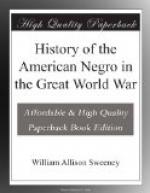by the dents and scars in some of them.
Their eyes were straight forward and their chins,
held high naturally, seemed higher than ever because
of the leather straps that circled them.
The fighters wore spiral puttees and their heavy
hobbed hiking shoes, which caused a metallic clash
as they scraped over the asphalt.
“At the head of the line rode four platoons of mounted police, twelve abreast, and then, afoot and alone, Col. Hayward, who organized the 15th, drilled them when they had nothing but broomsticks to drill with, fathered them and loved them, and turned them into the fightingest military organization any man’s army could want.
“The French called them ‘Hell Fighters.’ The Germans after a few mix-ups named them ‘Blutlustige Schwartzmanner’ (blood-thirsty black men.) But Col. Bill, when he speaks of them uses the words ’those scrapping babies of mine,’ and they like that best of all. Incidentally (when out of his hearing) they refer tenderly to him as ‘Old Bill, that fightin’ white man.’ So it’s fifty-fifty.
“The Colonel had broken a leg in the war, so there were those who looked for him to limp as he strode out to face the hedge of spectators that must have numbered a quarter of a million. But nary a limp. With his full six feet drawn up erectly and his strong face smiling under his tin hat, he looked every bit the fighting man as he marched up the centre of the avenue, hailed every few feet by enthusiasts who knew him socially or in the law courts or in the business of the Public Service Commission.
“‘Didn’t your leg hurt you, Bill?’ his friends asked him later.
“’Sure it
hurt me; he said, ’but I wasn’t going to
peg along on the
proudest day of my life!’
Which this day was.
“Behind the Colonel
marched his staff, Lieut. Col. W.A.
Pickering,
Capt. Adjutant
Robert Ferguson, Major E.A. Whittemore, Regimental
Sergt. Majors C.A.
Connick and B.W. Cheeseman, Regimental Sergts.
L.S. Payne, H.W.
Dickerson and W.W. Chisum, and Sergts. R.C.
Craig,
D.E. Norman and
Kenneth Bellups.
“The Police Band was at the front of the line of march, but it was a more famous band that provided the music to which the Black Buddies stepped northward and under the Arch of Victory—the wonderful jazz organization of Lieut. Jimmie Europe, the one colored commissioned officer of the regiment. But it wasn’t jazz that started them off. It was the historic Marche du Regiment de Sambre et Meuse, which has been France’s most popular parade piece since Napoleon’s day. As rendered now it had all the crash of bugle fanfares which is its dominant feature, but an additional undercurrent of saxaphones and basses that put a new and more peppery tang into it.
“One hundred strong, and the proudest band of blowers and pounders that ever reeled off marching melody—Lieut. Jimmie’s




